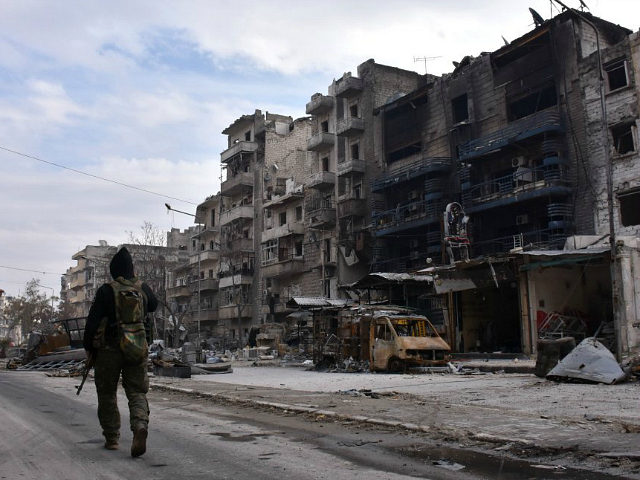The headlines on Day One of the latest Syrian ceasefire, this time brokered by Russia, Turkey, and Iran without U.S. or U.N. involvement, is that it’s holding together despite “minor violations” — such as 20 air raids by the Syrian government against rebel positions near Idlib and ground action supported by attack helicopters in the suburbs of Damascus.
“An official from the Nour al-Din al-Zinki rebel group said government forces had also tried to advance in southern Aleppo province,” Reuters adds, noting that Iran-backed Hezbollah forces denied the reports of Syrian airstrikes, while Syria’s military itself was silent on the matter.
“Opposition activist Mazen al-Shami, who is based in the Damascus suburb of Douma, said minor clashes nearby left one rebel wounded. Activist Ahmad al-Masalmeh, in the southern Daraa province, said government forces had opened fire on rebel-held areas,” writes the Associated Press.
Syrian ceasefires are always graded on a curve, but airstrikes, artillery barrages, and helicopter assaults make for a rather steep curve. Adding to the confusion, it remains unclear exactly which rebel groups are covered by the ceasefire.
The Syrian army is disputing statements by several opposition commanders that al-Qaeda’s force in Syria, the Nusra Front (recently renamed to Jabhat Fateh al-Sham) is covered by the agreement. Sky News cites rebel leaders saying they believed the ceasefire should apply to “all of Syria, including areas where Fateh al Sham was present.”
Reuters adds that the Islamist group Ahrar al-Sham, an ally of al-Qaeda, declared it would not sign the ceasefire agreement, due to unspecified “reservations.”
The New York Times quotes the London-based Syrian Observatory for Human Rights claiming rebel groups had breached the ceasefire in Hama Province, while a rebel spokesman claimed the government had broken the truce by shelling villages in neighboring Idlib Province.
The Times quotes analyst Sam Heller of the Century Foundation critiquing the Russian ceasefire effort as based on little more than “pure positive thinking and momentum.”
There’s some of that going around on the other side as well. The Times found a rebel spokesman describing the ceasefire on Twitter as “a new opportunity for the revolutionaries to get their house in order and prepare for all coming possibilities to topple the regime, militarily and politically.”
Sky News adds that Russian fighter jets hit ISIS positions around the northern Syrian town of al-Bab three times over the past 24 hours, in what appears to be air support for Turkish ground operations in the area. Turkish media said 12 Islamic State fighters were killed by the Russian airstrikes, while another 26 were killed by Turkish air operations in the area, and one Turkish soldier was killed in an ISIS ground attack. ISIS is not covered by anyone’s version of the ceasefire agreement.
Writing at the UK Guardian, Ranj Alaaldin dismisses the ceasefire as worthless until it covers all of Syria and treacherous as it leaves Syria, Russia, and Turkey with plenty of latitude to bomb anyone they consider “terrorists,” while much of the opposition lowers its weapons.
Alaaldin also makes the interesting observation that a rift between Russia and Iran may be opening up in Syria, adding to Russia and Syria’s unresolved tensions with Turkey:
As Iran’s disruption of the Aleppo evacuation process two weeks ago showed, it is Iranian proxy militias and other Assad loyalists who control the local political and security environment and will ultimately decide the fate of ceasefire arrangements. Yet, Russia has no control over these groups, who do not necessarily have the same long-term political and geopolitical objectives as Moscow. As these militias and other Assad loyalists make further gains, they are likely to grow increasingly assertive and diverge further away from Russia’s sphere of influence.
Much attention now turns to Idlib, where many of today’s alleged ceasefire violations took place. There have long been fears that the Assad regime would herd rebel forces — and undesirable civilians — into Idlib for slaughter by Syrian and Russian air power in a bloody finale to the Syrian civil war.
The Australian reports on what appear to be preparations for a final assault on Idlib:
During the past two weeks up to 44,000 people, most of them civilians, have been evacuated from a small pocket of rebel-held territory in eastern Aleppo and sent to the countryside west of the city. Since then Russian and Syrian jets have carried out air strikes on towns where the displaced are sheltering.
Fars News, Iran’s state news agency, has reported that Russian fighter jets are preparing to carry out 5,000 sorties over Idlib before the start of a huge ground operation. Iran is an important ally of Assad, with thousands of members of its Revolutionary Guard, as well as its proxy Shia militias, fighting in Aleppo.
“The Syrian army that has just liberated Aleppo city will get ready to start a large-scale operation in Idlib province that is the main bastion of Fateh al-Sham Front,” a source within Syria told the agency. “After a week of heavy missile, artillery and air attacks and destruction of Fateh al-Sham’s bases, the ground operation will kick off.”
Perhaps the value of the Russian-Iranian-Turkish ceasefire initiative will be judged by whether this mobilization for a bloodbath in Idlib continues.

COMMENTS
Please let us know if you're having issues with commenting.